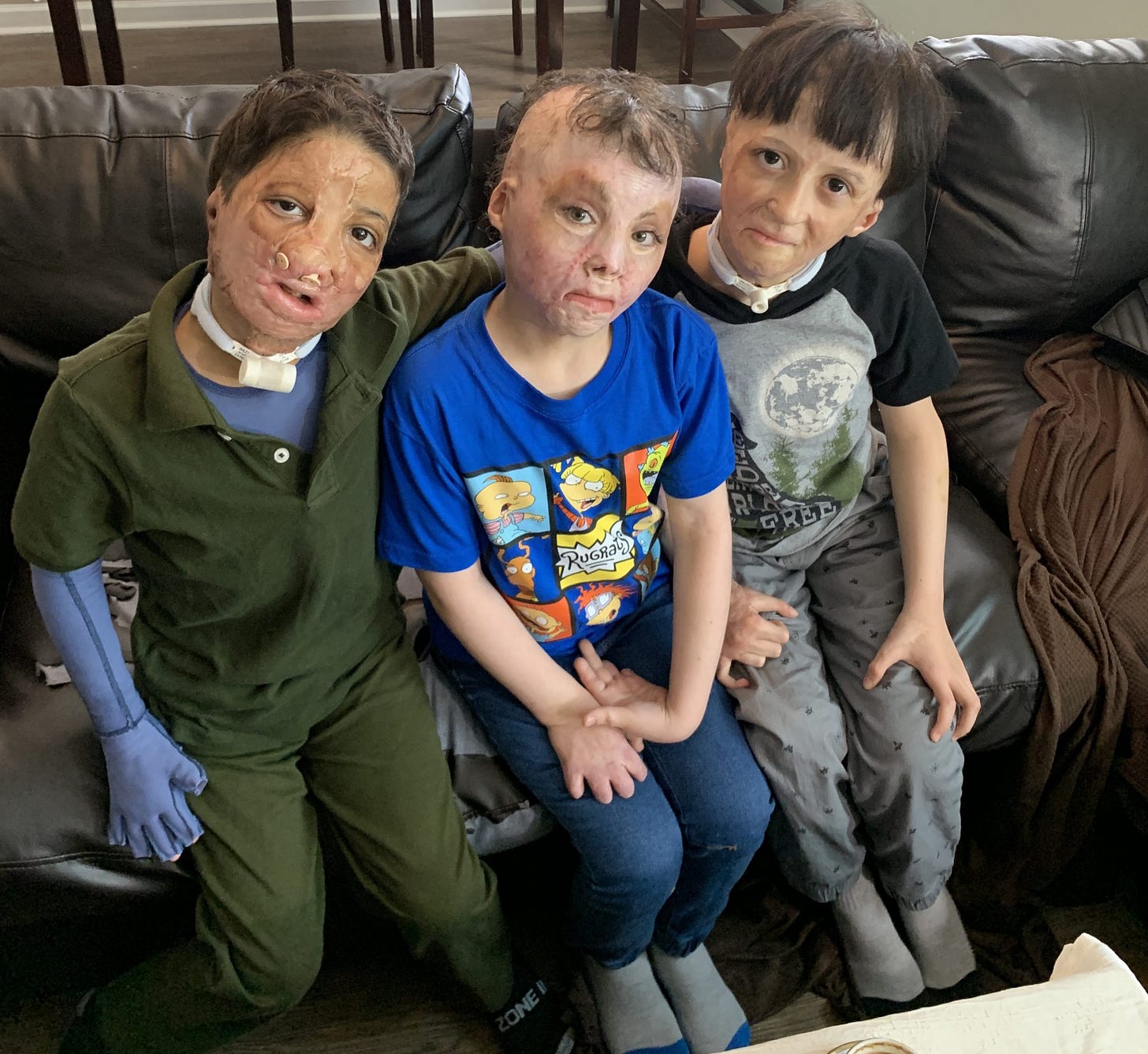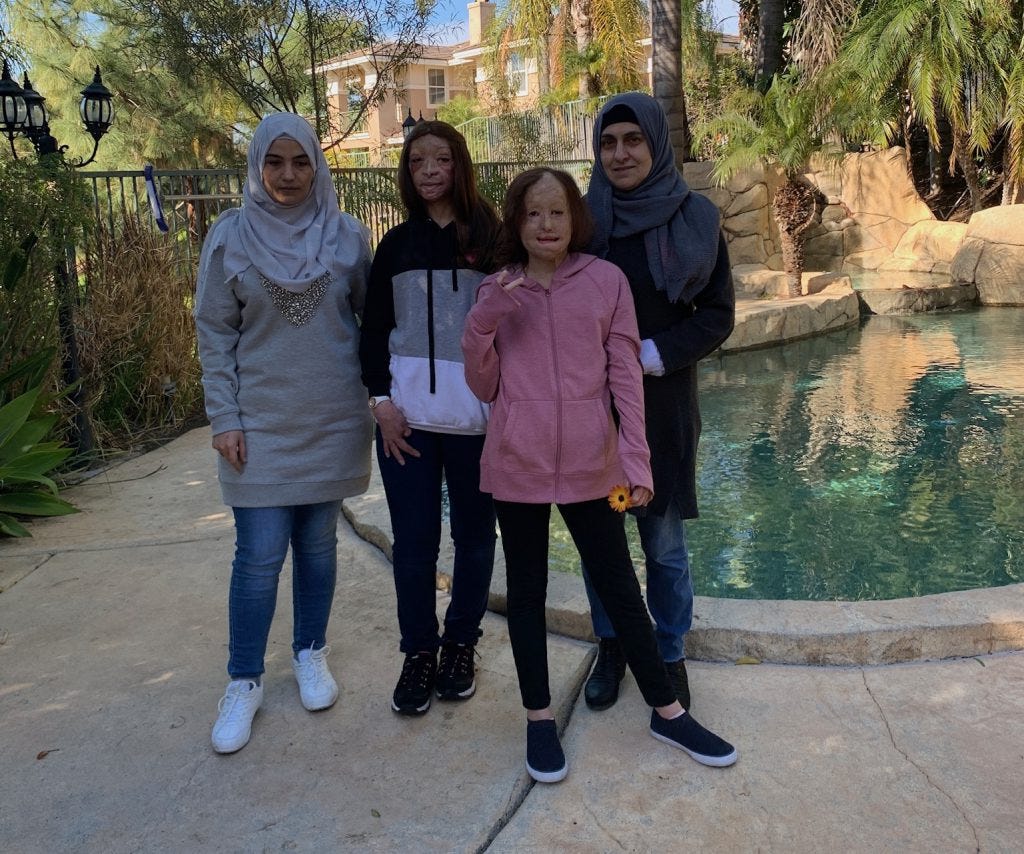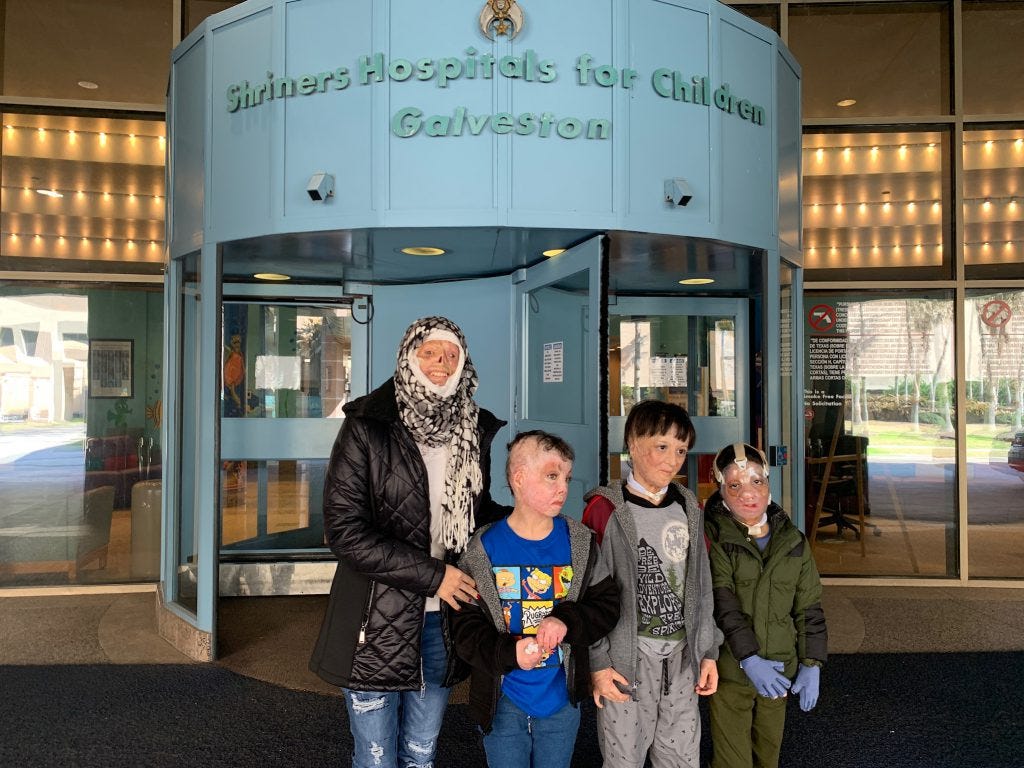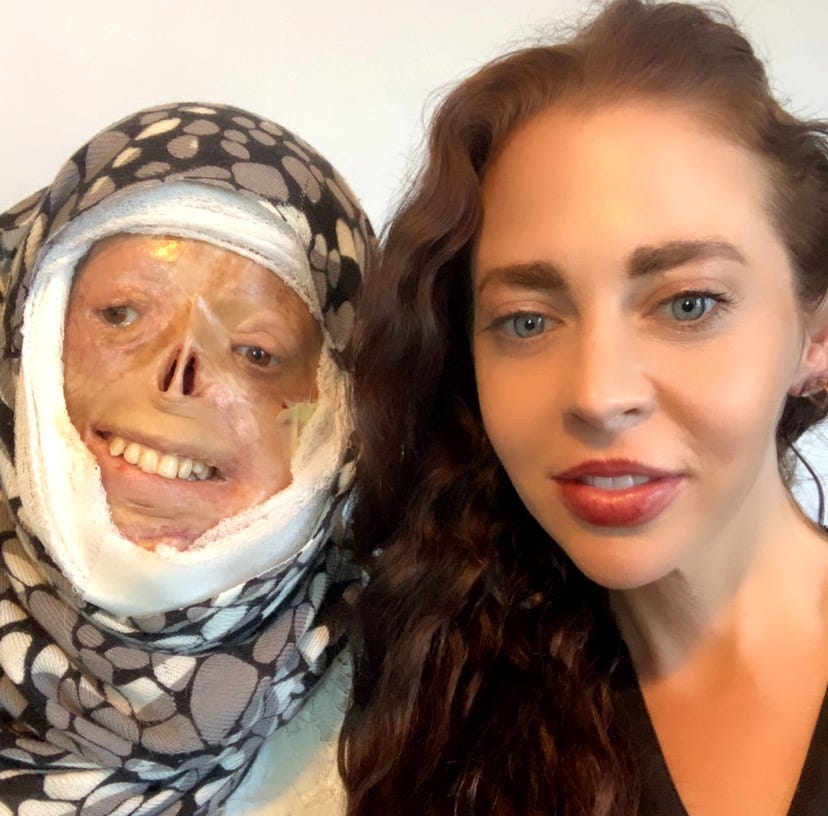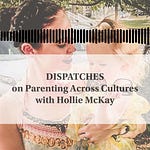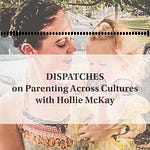“I didn't write to be famous; I wrote to keep a record.”
- Gloria Emerson, war correspondent 1929-2004
The budding and innocent always bear the brunt of war, its height and its aftermath.
People often ask me what they can do to help children caught in the crossfire of conflict, who to support and what can be done. Years ago, while still living in Los Angeles, I had the great fortune of meeting Syrian-Americans Saed Moujtahed and Susan Baaj. They had just started an organization entitled Burnt Children Relief, specifically to support Syrian children burned by bombs. (IG: @helpbcrf).
“Helping one person might not change the world,” Susan said to me. “But it could change the world for one person.”
I met some of the children and immediately fell in love with their gentle demeanors and courage. I was left in awe of their buoyancy: what it means to be brave, fight, and endure.
Allow me to introduce you to these incredible children and why they clutched my heart and never let go.
A bomb ripped through Yazen's family home in Al-Bab, Syria, on a frigid winter afternoon in 2016.
Eighty percent of the child's body caught fire and melted, including his lungs, sending him into a coma from which he didn't wake for six months. Yazen lost the ability to speak and relies on a machine to breathe.
Yet it was a traumatic flight from Istanbul to Los Angeles several years ago that gave Yazen and his mother, Kawthar - a teacher from Homs, Syria - their first glimpse of the generosity of America's front-line medical workers.
The breathing machine voltage was incompatible with the aircraft. As a result, Yazen's tracheotomy filled with fluid very quickly, and he was unable to breathe. The airline staff appealed to any doctors on board. An American anesthesiologist volunteered, and a Jordanian nurse offered to translate for the petrified mother. The doctor requested that the deeply distraught Kawthar move to a different part of the plane so she could not see the horrors that soon unfolded.
Yazen's doctor inserted a tube in his trach hole and sucked his saliva out himself, spitting it out continuously to prevent a blockage of his airway. He did this for the entire flight, as passengers prayed and cheered for the child in his fragile fight for life.
“The way we were supported, immediately I knew that we were in the right place,” Kawthar says softly. “People are kind to us when we walk in the streets. Nobody stares at my son like he is different.”
Like many Syrian war survivors, Kawthar requested that only her first name be published due to security concerns.
Yazen was whisked away to a hospital once he landed, and the heroic doctor remains anonymous. Social media posts by the Burnt Children Relief Foundation (BCRF), which brought Yazen and many others to the US for emergency surgery, have fallen on deaf ears.
And yet this doctor remains akin to an angel. The doctor saved Yazen's life. After dozens of operations, the ten-year-old boy - doll-like with his delicate features and wide ebony eyes - is full of light and wisdom. Without a voice, he makes a heart shape when I ask about his experience so far in the US.
Then there is Hamama, who in 2016 came to the US for a second chance at life.
It's her face you notice first - roasted raw and unrecognizable. She has a gaping hole where her nose once was; prosthetic eyes that cannot shed tears. What you remember most is the softness of her hands - a glimpse of the innocent girl who lived before the bomb fell on her family's home in the Homs countryside six years ago.
Hamama's entire family, her memories, her eyesight, and her face were all lost in an instant. Nevertheless, this sweet soul has learned to reassemble the pieces of a broken past - one shard at a time - since arriving in the US several years ago.
Over a dozen Syrian children have been able to undergo lifesaving surgery in the United States with the help of the US State Department and the all-volunteer Burnt Children Relief Foundation. Some live in Texas, where they are treated at Shriners Children's Hospital in Galveston, and others live on the outskirts of Los Angeles. Each child is a window into a world of front-line medical workers, and a kind of generosity that they never knew was possible.
As the Syrian War escalated to unfathomable levels, BCRF was formed in 2014. As part of the bombing campaign led by the Bashar al-Assad regime and his Russian partners, hospitals were targeted. According to Physicians for Human Rights, at least 595 attacks have taken place on more than 350 medical facilities. In addition, nine hundred thirty medical personnel have been killed. There is still bloodletting going on inside the once beautiful country - the "Cradle of Civilization."
It has been almost eleven years since pro-democracy protests filled the streets of Daraa in the south of Syria. Initially peaceful demonstrations, which called for democratic reforms, soon became violent police crackdowns. Outside agendas also invaded the theater of war, igniting one of the world's worst humanitarian crises: a situation further exacerbated by the international community's inability or unwillingness to intervene.
The past decade has been marked by cruelty, death, destruction, displacement, and poverty. Chemical weapons have crushed medical facilities and civilians. Almost every square inch of the wracked land has been marred by sexual violence, torture, and war crimes.
However, as is so often the case in wars, civilians, especially children, are most tragically caught in the crossfire. In fact, horrible burns are analogous to the conflict in Syria, where bombs indiscriminately strike schools and homes.
The UN estimates that hundreds of thousands of Syrian children have been killed or injured by the war. In a report by UNICEF, the number of children showing indications of psychosocial distress doubled last year as they continue to live amid the tangle of buildings and the tents they now call home while enduring the shock and horror of combat.
For most Syrians, who were barely making ends meet when adversity struck, there is a painful sense that they will never receive justice or accountability for what was done to them. International tribunals are notorious for their arduous process and bloated bureaucracies that rarely prosecute. Yet, coming to America for critical surgery is a small victory against the tyrants who tore their lives apart.
Manal, now fifteen, undergoes a number of surgeries in California and views herself as one of the lucky ones.
“I didn’t feel anything until I woke up,” she recalls. “And then everyone told me I was burned.”
But Manal bears a wisdom far beyond her tender age.
“I’ve learned a lot. It is making me more brave and making me feel other people’s pain, a feeling only people in this situation would know. I feel their pain, and I want to help them,” she says politely, her body stoic and erect. “This has made me more determined to achieve my goals in life. I want to be the voice for other people. I want to be a doctor to help the society.”
But when Manal reflects on the tragedy that is Syria, her resilient face starts to break into a map of memories, of deep-seated angst. Her tears turn to guttural sobs as she mourns the children left behind, who don't have access to help like she has; the burned stumps where her hands once were scoop up tissues to dry her misty eyes.
“There are so many children like me,” Manal continues, grief catching in her throat. “And no one is helping them; please help them because they deserve a better life.”
Her mother, Nisreen, weeps for what this war has become.
“I used to want to stay in my country,” she whispers between silent whimpers, her body trembling. “But I don’t want to be there anymore. I am so happy to be here. No one could help us in Syria. But whatever I can say now about my country, it means nothing. It is a drop. The situation is a disaster, and no one can help with that.”
Despite Syria's unfathomable number of seared children, BCRF can only handle the most intense burn cases. The list of the severe is large - more than 1,650 remain. There isn't a single day that passes when BCRF chairwoman Susan Baaj isn't bombarded by new cases, desperate pleas, and requests.
“I used to watch all the videos and images of the bombs falling and hospitals decimated,” notes Baaj, a Syrian American businesswoman and philanthropist in Southern California. “I just started to feel helpless, and I am a results person. I need to see results, and I wanted to see something happening here.”
A plastic shield covers Musa's charred face and his skin is covered in a suit and gloves. His nine-year-old frame appears far too diminutive for his age. The elastic silence between sentences is punctuated by the haunting sound of this child's heavy breathing as he speaks in a tempered staccato.
“I like America better,” he asserts with a cheeky grin. “There are more toys here.”
Musa was four years old when he was hit from the skies in the Syrian city of Raqqa; his skin scorched in a way that doctors have questioned whether the bomb used phosphorus or an equivalent chemical. Musa's baby sister died instantly. Musa's mother, Sabrine, tells me her son's injuries were caused by an old diesel heater exploding as the bomb landed.
“The situation for children in Syria is very dire,” Sabrine says, her eyes darting to the heavens as she speaks. “We’re all just very tired of this.”
Still, Musa wants to go home someday. He wants to go back to school, which was reverted to online learning at the outset of the global pandemic. And he already knows what he wants to be when he grows up.
“A policeman,” Musa enthused, a smile contorting his flushed face.
Anwar, who is also eight years old, is also interested in becoming a police officer. The boy mentions he met police officers in Texas. When Anwar's body was blistered into oblivion at three years old, his family lived in the former ISIS stronghold of De-Azor. In the midst of war, he left behind his beloved siblings and he has no memory of them.
“I am a burn victim,” he utters when asked what he wants to share about himself. “And thank you to the American people.”
Baaj also views BCRF’s visa policies as an important model, especially during a time of large-scale debates over immigration, refugee numbers, and Americans’ needs.
Unlike most other resettlement programs, the foundation allows only one family member - which must be a woman - to accompany the burned child. The US government does not grant them permanent residency, only a visa for the period of treatment, which usually ranges from six months to two years. After the visa expires, the child must be repatriated with their surviving family overseas, usually to Turkey or Syria.
Regardless, the journey still comes at a high cost for the mothers who accompany their children to treatment - they are forced to leave behind their loved ones and other children for months or years.
Khatoon, who is Anwar's mother, also has seven other children who she has had to separate from for an unknown length of time. She remembers clearly the day her baby boy was burned. She remembers leaving the house for a funeral on a frosty morning, only to return to find a smouldering pile of rubble.
The injured Anwar had already been rushed to the Turkish border, and she wandered the war-torn streets for three months until they were reunited.
“He used to cry a lot, and he wasn’t able to look at himself in the mirror. Sometimes he still gets sad, but he never complains,” Khatoon stammers, her eyes wet. “I miss my other children, but I had to come here for Anwar. I would tell any parent in this situation, don’t give up on your children.”
The mothers lean in, quietly confessing that culturally, there is still a lot of stigma surrounding severely wounded children in their homeland. Often, they are abandoned and deemed too costly by struggling families. Additionally, these young survivors were afraid of being ostracized due to their appearance when they first came to the US. But they actually found the opposite to be true.
“I thought it was going to be weird and scary. At first, I was scared with everyone looking at me,” admits Ayesha, who was scorched when she was just four in Idlib. “But I learned here, never judge a book by a cover. Be kind and don’t judge.”
Syria is a fragmented memory for Ayesha. She recalls her feeling of exhaustion, of feeling unsafe, and then those moments before the injury. Her thoughts shift to the aftermath, the flood of displaced persons over Turkey's border and back into Syria, even as the conflict peaked.
“Never give up,” she adds while scrolling through her toddler photographs — evidence of the life “before.”
“Even when you think hope is lost, it is going to be back in you.”
You can learn more about Manal’s experiences through her new YouTube channel.
And you can check out my interview on the Undaunted Life podcast here.
For those interested in learning more about the aftermath of war, please pick up a copy of my latest book “Only Cry for the Living: Memos from Inside the ISIS Battlefield.”
Also if you want to support small business:
And also now available Down Under!
Thanks again for your support. Follow me on Instagram and Twitter for more updates



